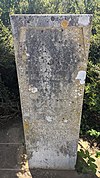Gilbert Charles Bourne

Gilbert Charles Bourne FRS (5 July 1861 – 9 March 1933) also known as 'Beja' Bourne, was a British zoologist.[1][2]

Bourne was admitted as an undergraduate of New College, Oxford, before becoming a Fellow of Merton College, Oxford and Linacre Professor of Comparative Anatomy at the University of Oxford from 1906 to 1921.[3][4]
Whilst an undergraduate, Bourne rowed at bow in the winning Oxford crew in the
Robert Croft Bourne, also rowed for Oxford, stroking them to wins over Cambridge in the Boat Race in 1909, 1910, 1911, and 1912.[5]
Bourne was a rowing coach and theorist. He designed racing boats, and modelled the gearing of oars. In 1925 he published "A Text-Book of Oarsmanship with an Essay on Muscular Action in Rowing", which was an early treatise on rowing technique.[6]
Apart from his scientific work, Bourne was a keen soldier. He was an officer in the 4th (
First World War and was appointed Honorary Colonel of the 12th Battalion, the Gloucestershire Regiment.[8][1]
References
- ^ a b "Royal Society - Gilbert Charles Bourne. 1861-1933". Royal Society. Retrieved 14 November 2016.
- . Retrieved 14 November 2016.
- ^ Levens, R.G.C., ed. (1964). Merton College Register 1900–1964. Oxford: Basil Blackwell. p. 52.
- ^ "A History of the Department". Department of Zoology, University of Oxford. University of Oxford. Archived from the original on 12 November 2017. Retrieved 19 November 2016.
- ^ "The Bournes: 2 – 'The Ugly Stroke'". 3 June 2010.
- ^ "The Bournes: 3 – the Theoretical Coach". 4 June 2010.
- ^ "No. 27169". The London Gazette. 27 February 1900. p. 1354.
- ^ Craig, E.S., ed. (1920). Oxford University Roll of Service. Oxford: Oxford University Press. p. 183.
